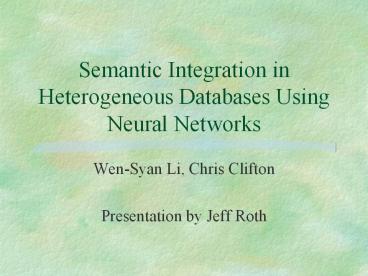Semantic Integration in Heterogeneous Databases Using Neural Networks PowerPoint PPT Presentation
1 / 13
Title: Semantic Integration in Heterogeneous Databases Using Neural Networks
1
Semantic Integration in Heterogeneous Databases
Using Neural Networks
- Wen-Syan Li, Chris Clifton
- Presentation by Jeff Roth
2
Introduction
- Basic schema matching problem
- GTEs data integration project included 27,000
data elements - This took 4 hours per data element or 25 full
time employees 2 years to complete - This method -gt .1 seconds, 144000 x faster
- how to match knowledge is discovered
3
Method Outline
- The end user is able to distinguish between
unreasonable and reasonable answers, and exact
results arent critical. This method allows a
user to obtain reasonable answers requiring
database integration at a low cost
4
Automated semantic integration methods
- Attribute Name Comparison
- This method is not used in this paper
- Attribute values and domains comparison
- Equal, Contains, Overlap, Contained-in and
Disjoint - Used but not with the above measures
- Field Specifications
- Data type, field length constraints and others.
- This is also used in this method
5
Field Specifications
- The following measures are used
- data types
- Each possible data type has a network input,
with the field data type having a value of 1 and
all the other having a value of 0 - field length
- Length 2 (1/(1 k-length) - 0.5)
- format specifications
- similar to data type
- constraints (primary key, foreign key,
disallowing nulls, access restrictions, etc) - similar to data type
6
Attribute Values and Domains
- Divide measures into character fields and numeric
fields - Patterns for Character fields
- 1. Ratio of numerical characters
- Address 146 South 920 West would score 6/18
- 2. Ratio of white space
- Address 146 South 920 West would score 3/18
- 3. Length Statistics
- Average, Variance, and coefficient of the
used length relative to the maximum length
7
Attribute Values and Domains cont.
- Patterns for numeric fields
- 1. Average (mean)
- 2. Variance
- 3. Coefficient of variation
- Recognizes similarity between values of different
Units and Granularity - This can also help recognize which fields may
need unit conversions - 4. Grouping
- For example area code, zip code, first three
digits of SSN
8
Self-Organizing Grouping algorithm
- N number of possible discriminators
- M number of categories, this can be adjusted by
user. ideally this is attributes - foreign
keys - This is unsupervised, i.e. you dont have to
provide a correct classification, it simply
groups based on similarity
9
Training the Back-Prop Network
- Inputs (N) are identical to classifier
- Outputs (M) are trained using Back-Propagation
and classifiers results - Categories are labeled with the attributes they
grouped together
10
What is the classifier for?
- Ease of training
- ideally M is attributes - foreign keys
and it is less computationally expensive to train
M classifications where M lt attributes -
foreign keys - It is less computationally complex to compare new
elements to the M classification than to ever
attribute of the training database or
attributes - foreign keys - Networks can be trained in which there there are
attributes that are identical
11
Integration Procedure
2
1
3
6
4
5
- 1. DBMS Specific Parser
- 2. Classify (Categorize) Training Data
- 3. Train Neural Network
- 4. DBMS Specific Parser
- 5. Classification by Neural Network
- 6. User Checks Results
12
Results
13
Conclusion and Future Work
- Human Effort needed for semantic integration is
minimized - Different Systems have different attribute
properties available - automated solution - Extend to automated information integration
- C source code available at eecs.nwu.edu/pub/semint

